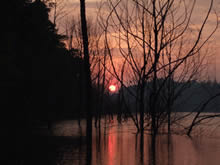
Sebarau Search Lure techniques
Rushing to get the boat on the water, we finally loaded up in the early dawn. Soon we found a potential looking spot. Shutting off the engine, we glided within casting range of the prospective looking area. Scrabbling through my tackle box overflowing with lures, I hunted for a lure that felt right for the place.
After casting around with no bites, we moved off to another spot. Wondering what lure to try now, I went through the same process, peering into the tackle box, trying to pick the lure that would prove to be “the one”, the ultimate lure that would bring the fish in that day.
Clipping on another lure, we worked the new structure. Again there were no bites. Before moving off, we spent half an hour trying out a few more different lures, but there were no takers. And so the process went on as we continued our search for sebarau in the new waters we were exploring.
In the past this was our typical scenario when fishing new waters for sebarau. There are always so many things to find out. Where to fish, when to fish and what lure works are some of the things we strive to solve. Finding where to fish can be a daunting task. At times, every where you look looks fishy. There are times we may have been fishing with the wrong lure in a place teeming with sebarau, but since the chosen lure is ignored by the fussy sebarau, the place is declared fishless.
The other scenario is where prospective looking spots with no fish are hammered with numerous types of lures in the hope of finding the hot lure of the day for a long duration with no results. The time taken to work the one spot (that has no fish) with a lot of different lures will end up with a lengthy waste of time that could have been better spent covering more new places. No matter how fishy places may look, there may not be sebarau holding there.
Fishing like this I discovered became very much a hit and miss affair. Spending time to try out many lures wastes time if fishing the wrong area. Casting with the wrong lure in a fish holding spot will also result in a fishless session. If the fish were on a bite, it would be easy enough to discover their hang outs. At those hot times, throwing them almost any lure would result in an attack. However more often than not, the sebarau would be quiet and searching for them needs to be more systematic rather than having a randomised method of using lures.
In another article (Sebarau Haunts), the many likely spots where sebarau hang out were covered. The common lure types that sebarau favour were covered in the Sebarau Lures article. Now we will cover using lures from a different angle, how to refine our choice of commonly used lures. Though we may have a bunch of lures that sebarau frequently go for, we still need to fine tune our prime lures for the occasion.
When searching for sebarau, seasoned sebarau anglers tend to use only a few different types of lures though they may have many more different types on hand. The newer sebarau hunters tend to be more experimental, changing lures every few minutes, hoping to find the secret weapon that works for the day.
Understanding that sebarau generally have a certain preference, it is more efficient to cover the water with what is often called searching lures when looking for fish. Experienced anglers often use their preferred prime search lures as their first choice. These lures are the ones that work often and regularly for various reasons.
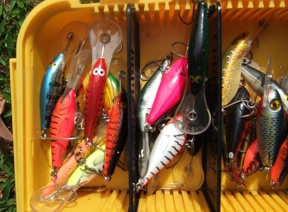 The reasons are normally the action, size. profile and depth. They are somehow a very generic lure that works in most situations. Therefore through an angler’s experience they become the prime search lure based on the angler’s perception of the lure’s reliability.
The reasons are normally the action, size. profile and depth. They are somehow a very generic lure that works in most situations. Therefore through an angler’s experience they become the prime search lure based on the angler’s perception of the lure’s reliability.
More importantly, the angler has the faith in the lure. Confidence is important. Without it the enthusiasm dies, and the casting becomes less frequent and therefore chances of catching something reduces proportionately. When there is confidence in the lure, the angler will cast more frequently to every likely spot and with passion, believing that if there is a sebarau there, it will hit the lure. With this belief, the rate of success is higher due to more water getting covered in that time the lure is being used.
Talk to a handful of seasoned sebarau anglers and they will probably each have their own favourite search lures. Does it mean that only psychology is involved in having a successful search lure? In part, yes, but the right searching lure characteristics are needed. Most of the time those different favourite search lures of different anglers will have similar characteristics that make them successful. These lures have universal traits that sebarau everywhere tend to love.
My definition of a search lure is the lure that I would pick up first to cover unknown water, and this would likely be the same lure fished throughout the day even after the sebarau have been found. However, there may at times be some occasional lure changes to suit differing environmental requirements or situations.
Some may ask, “Why bother calling it a search lure then?” Just use it all the time. It is a search lure because it gives the angler the best chance of finding the fish. Often the search lure may just find the “tip of the iceberg”. This means that in a tough situation the search lure may find a gullible sebarau that falls for the generic lure, but the other sebarau in the same locality are a bit more recalcitrant and may prefer something more local in taste.
Once the sebarau are found with the search lure, it gives the angler more confidence of the presence of other sebarau. With this confidence, more sebarau can be sought in the same area or similar structure type. The same search lure can be used or other lures can be trialled, expanding the lure pattern “search” to find the key lure to unlock the hot bite for the day.
It also may mean that the few gullible sebarau are the ones on the outer fringes of where the main school has been holding and working the area more thoroughly will produce more sebarau. Alternatively they may have been holding deeper and getting a deeper diving lure down may produce the hot bite of the day. It can also mean that by changing lures to maybe a smaller lure which the sebarau may prefer that day will bring on the main bite.
In short, it is the lure that can cover water rapidly that will most likely entice a strike without the need to work an area in great detail as it is generically the most likely to succeed without going into speciality lures (lures for specific situations) though the search lure may in itself be a speciality lure.
Here is a good example of when a search lure was successful in locating the sebarau, but the knowledge was not taken advantage of when I was guiding a foreign friend, fly fishing for sebarau. We were fishing in a dam that I knew there were sebarau, but I was not too familiar with the fishing spots at the time as I had only just started fishing that dam.
I brought him to a spot which looked good. He did not catch any sebarau at that spot but I was using a lure which had a hit and a scale was left behind on one of the hook points. A few half hearted attempts later we moved to another spot.
That lure I was using at the time was still relatively new to me. It was not a search lure yet, as I only later realised how good it was at finding sebarau. You see, a few months later still thinking of the little bump and scale left behind, I went back to that same spot and worked the area more thoroughly and also deeper.
It turned out that the sebarau were holding down deeper than I was originally working. We ended up hooking over a hundred sebarau in those snags over several trips. If only I had taken more notice of the little bump the soon-to-be search lure had, and worked the area more seriously, my fly fishing friend would have had an unbelievable fly fishing day (He did hook up a few fish, but it was not a hot fishing session).
Though the 5 cm Tilsan bass is my primary searching lure, if I am in a situation where I know the sebarau mainly prefer only minute baitfish, my searching lure would have to be changed to something smaller, probably a small flashy spinner. Though small lures normally do not catch the monster sebarau, they will search out any sebarau in the area, which will typically be small.
I have a friend whose search lure is a home made 4 cm lure. He frequently fishes a locality where the sebarau regularly feed on small clear baitfish, so he came up with his own model. It is his prime sebarau search lure for that locality.
What about going up in size? For instance a 12 cm lure. That would be defined as a speciality lure, in my book, not a searching lure. Speciality lures would normally be used where there are known to be sebarau and special features of the lure may be required to get a bite.
Another characteristic that can make a variation in search lures is depth. Searching a shallow weed bed with a deep diving crankbait would be impossible. A shallow running crankbait with the right criteria or a spinner or a spoon that is cranked rapidly to keep it near the surface would make a better search lure. Additionally, the baitfish and sebarau found in shallower waters tend to be proportionally smaller, so successful search lures for such waters tend to be small, about 3 cm in length or even smaller.
Likewise, using a shallow running search lure to search deep structure would be quite a ridiculous choice. Though spinners and spoons can be used to reach deep structure with a yo-yoing jig style, deep diving crankbaits are my preference as their depth control is more constant throughout the retrieve.
Overall I mainly use a mid-depth diving shad shaped crankbait in most circumstances. Where the conditions are shallower than the normal diving depth of the crankbait, the lure can be made to run shallower by raising the rod tip high and continue the retrieve of the lure with the tip held high which shallows the running depth of the lure. This way the depth of the diving crankbait can be varied. If I feel that the sebarau might be down in the deeper snags out of range of my standard search lure, I will change to my primary deep water search lure the Halco poltergeist +8m lure.
The bibbed crankbait is also useful when working drop-offs as when it dives it vibrates at the same time. There was one case where I was working a small stream mouth where the base of the stream suddenly dropped off into the depths.
Casting near the side of the drop-off next to some submerged branches, as the lure dived out of sight, a sebarau appeared with a shiny flash and hit the lure. Subsequent casts did not elicit anymore catches. Knowing there would likely to be more sebarau holding there because of the attack on the search lure, and that they would likely to be small sebarau like the first catch, a small lure was used. This resulted in another three small sebarau being caught.
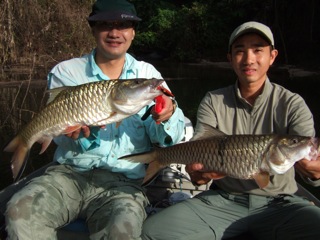 Through experience most anglers will settle down after some seasons to their favoured search lures in particular waters. How I came about my preferred search lure happened quite by accident. At the time I tended to use smaller 3-4 cm crankbaits, spoons and spinners for searching.
Through experience most anglers will settle down after some seasons to their favoured search lures in particular waters. How I came about my preferred search lure happened quite by accident. At the time I tended to use smaller 3-4 cm crankbaits, spoons and spinners for searching.
This normally resulted in some good small sebarau action. Then if there looked like there would be some bigger sebarau around, I would change to a bigger lure to search the area.
One day I was working a small twitch lure and had a reasonably sized sebarau follow it, coming out of the deeper water where it had been holding to look at the lure. The lure I had on did not have very strong hooks to handle sebarau of that size and did not twitch very deep. So I looked through my tackle box and selected a 5 cm lure that had some beefier hooks and also a bigger bib to work a bit deeper to get down to where the sebarau had been holding.
When I started using it I noticed it seemed to also consistently catch more fish. Thinking back on another trip at another location, I recalled that this same lure, though not used regularly, seemed to catch fish, even small sebarau each time it was used. You see, at the time I was often the lure experimenter, changing lures frequently.
On the following trips, I began to use this lure more and soon it became evident that this lure consistently caught sebarau of varied sizes in all sorts of waters with greater consistency. I began to have confidence over time in this lure and now it is my primary search lure. By having a consistent reliable lure, the search for sebarau is more systematic and refined.
Therefore having a range of search lures to cover different depths to match the possible variations in holding depth and also sizes to match the local common baitfish in residence will increase the chances of finding the sebarau.
Each angler by having his personal preferred search lures will be very familiar with the behaviour of the lure and can utilise its strong points to the maximum in different environments. Keep fishing and searching for sebarau and you will find your own personal search lures through your own personal experiences.
By being able to do a systematic and organised search in different environments with selected search lures, it increases the chances of finding the sebarau. Then once the sebarau are found, if necessary, the speciality lures can be brought into play to catch the sebarau.
Conservation
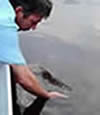
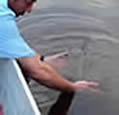
We need to protect and conserve our resources by practising catch and release of our sportfish and protecting the habitat of our fishes.
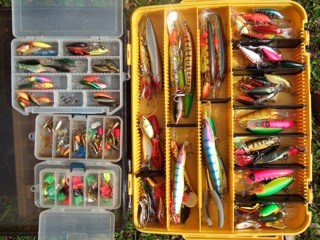
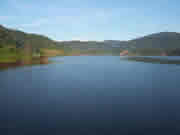
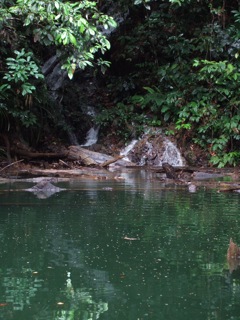
 The snags on the other side of this jungle river look perfect. What is the lure that will draw the fussy fish out?
The snags on the other side of this jungle river look perfect. What is the lure that will draw the fussy fish out?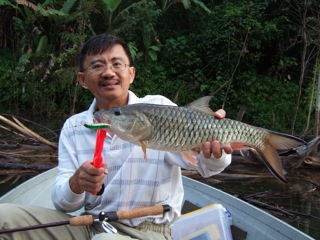

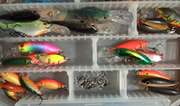 Small crankbaits are suitable as search lures or secondary lures once the sebarau have been found.
Small crankbaits are suitable as search lures or secondary lures once the sebarau have been found.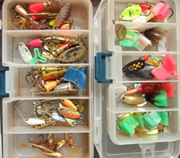 Spinners make good search lures for shallow waters encountered.
Spinners make good search lures for shallow waters encountered.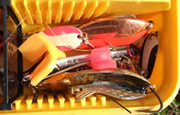 Spoons are also good search lures for constant retrieve techniques to search the upper water column.
Spoons are also good search lures for constant retrieve techniques to search the upper water column.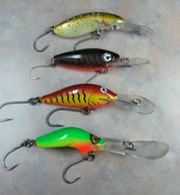 The generic search lure is normally about 5 cm in body length.
The generic search lure is normally about 5 cm in body length. My own preferred choice of search lure, the
My own preferred choice of search lure, the  Some anglers make their own custom search lures.
Some anglers make their own custom search lures.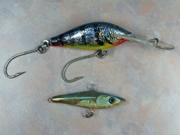
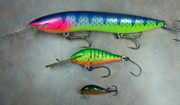 Once the search lure (middle) finds the sebarau, the small lure (bottom) will find small sebarau, and the monster lure (top) will entice the monsters, if any.
Once the search lure (middle) finds the sebarau, the small lure (bottom) will find small sebarau, and the monster lure (top) will entice the monsters, if any.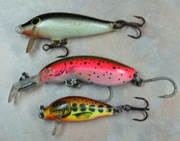 The small 1-3 cm crankbaits work well as search lures to seek out small sebarau in quantity.
The small 1-3 cm crankbaits work well as search lures to seek out small sebarau in quantity.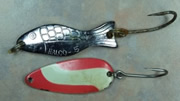 For spoons to be good search lures, they should be small, less than 5 cm and light with a good, hard wobbling action.
For spoons to be good search lures, they should be small, less than 5 cm and light with a good, hard wobbling action.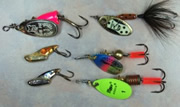 Small spinners, size 0 or 00, work very well as small sebarau search lures.
Small spinners, size 0 or 00, work very well as small sebarau search lures.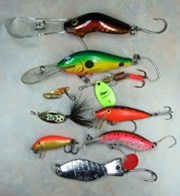 My search lure range for different situations and needs.
My search lure range for different situations and needs.